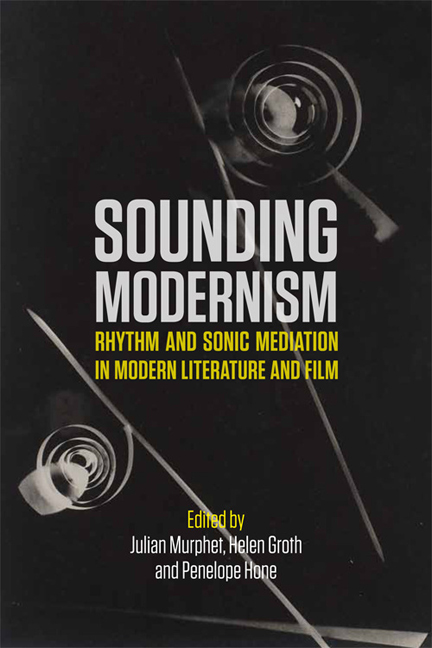Book contents
- Frontmatter
- Contents
- Acknowledgements
- 1 Introduction: Sounding Modernism 1890–1950
- Part One Writing Modern Sound
- 2 On Not Listening to Modernism
- 3 Advocating Auricularisation: Virginia Woolf's ‘In The Orchard’
- Part Two Mediated Voices
- Part Three Difficult Voices
- Part Four Modern Rhythm: Writing, Sound, Cinema
- Notes on Contributors
- Bibliography
- Index
3 - Advocating Auricularisation: Virginia Woolf's ‘In The Orchard’
from Part One - Writing Modern Sound
Published online by Cambridge University Press: 22 December 2017
- Frontmatter
- Contents
- Acknowledgements
- 1 Introduction: Sounding Modernism 1890–1950
- Part One Writing Modern Sound
- 2 On Not Listening to Modernism
- 3 Advocating Auricularisation: Virginia Woolf's ‘In The Orchard’
- Part Two Mediated Voices
- Part Three Difficult Voices
- Part Four Modern Rhythm: Writing, Sound, Cinema
- Notes on Contributors
- Bibliography
- Index
Summary
Referring in part to the technological advancements in acoustic media around the turn of the century (the invention and popularisation of the telephone, gramophone, radio and sound film), Melba Cuddy-Keane has insisted that there was a ‘new focus, in the modernist period [on] the act of auditory perception’. ‘In narrative’, she says, ‘this perceptual “turn” can be traced in both a consciousness of expanded sounds and a heightened sense of sound as something perceived.’ Though focusing more on the impact of the First World War, rather than on acoustic media, Sara Haslam has similarly suggested that ‘we need to refocus attention on the ways that the experience of war, and therefore the development of modernism, were mediated through sound’. Angela Frattarola adds yet another voice to the growing group of modernist scholars occupied with calling attention to the auditory dimension of modernist texts:
Modernists wanted their novels to sound out, to be listened to, and they achieved this by including the sounds of everyday life formally in their works and paying particular attention to how their characters are shaped by those sounds. In context, the formal experiments for which modernists are so well know [sic] – stream of consciousness, fragmented and nonlinear narratives, poetic prose – all hinge on a shift in sensibilities from the eye to the ear.
As the ranks of modernist scholars interested in unearthing the intricacies of the soundscapes of modernist literature grow, the need for terminology as well as an adequate framework for the study of these sounds becomes ever more pressing.
The absence of a theoretical framework for the study of ‘narrative sound’ is a common lament. Cuddy-Keane calls for ‘the development of a critical methodology and a vocabulary for analysing narrative representations of sound’ and even in the broader field of sound studies (where some take to literary texts to learn about the period's actual soundscape), scholars feel the need for ‘more and better conceptual building blocks to help us understand what we uncover’. The first place to look for a basis for such a framework, one would guess, is narratology. After all, what better way to study sounds represented in a narrative text than by analysing the way in which they are narrated and perceived? Narrative perspective, then, is key to gaining a better understanding of the auditory dimension of narrative texts.
- Type
- Chapter
- Information
- Sounding ModernismRhythm and Sonic Mediation in Modern Literature and Film, pp. 35 - 52Publisher: Edinburgh University PressPrint publication year: 2017



